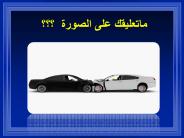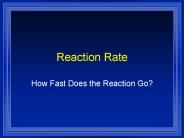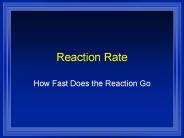Rate Of Reactions PowerPoint PPT Presentations
All Time
Recommended
CH 104: CHEMICAL KINETICS Chemical kinetics is the study of the rates of reactions. The rate of a reaction is the change in concentration per unit of time.
| PowerPoint PPT presentation | free to download
Chapter 14 Rates of Reactions Kinetics Chapter 14 Rates of Reactions Kinetics What should you notice about NO? 4) A catalyst acts by making available a new reaction ...
| PowerPoint PPT presentation | free to view
Rates of Reactions Speed or rate is measured by the amount of change that occurs in a given time interval Rates REACTION RATE The amount of time it takes to use up ...
| PowerPoint PPT presentation | free to download
Chapter 21 Section 4 Rates of Chemical Reactions In a chemical reaction Atoms are not created or destroyed, but are rearranged (Thank you, John Dalton!!)
| PowerPoint PPT presentation | free to view
Ch 12 Rates and Rate Laws Reaction Rate The change in concentration of a reactant or product per unit of time 2NO2(g) 2NO(g) + O2(g) Reaction Rates: 2.
| PowerPoint PPT presentation | free to download
Chapter 15: Chemical Kinetics Rates of Reactions How does a reaction take place? Consider: NO + O3 NO2 + O2 product molecules separate Molecules collide
| PowerPoint PPT presentation | free to download
RATE AND EXTENT OF REACTIONS RATE AND EXTENT OF REACTIONS Rates or reactions (reaction kinetics) - The rate at which something occurs is an indication of the change ...
| PowerPoint PPT presentation | free to download
Reaction rates typically increase with an increase in concentration of reactants. ... color, by adding the starch you will see a very sharp color change of blue/black. ...
| PowerPoint PPT presentation | free to view
SECTION 25.4 - Reactions approaching equilibrium ... Flash photolysis. Quenching. Chemical quench flow method. Freeze quench method. Rates of reactions ...
| PowerPoint PPT presentation | free to view
Long-Range TST for predicting rate constants of barrier-less reactions at low temperatures Yuri Georgievskii and Stephen J. Klippenstein Long Range TST At large ...
| PowerPoint PPT presentation | free to view
... polarity causes the carbon to become activated to substitution reactions with nucleophiles. Carbon-halogen bonds get less polar, longer and weaker in going ...
| PowerPoint PPT presentation | free to download
13.2 Expressions of Reaction Rates in Terms of Rates of Changes in ... hydrogen gas for buoyancy, the German airship Hindenburg burnt up in an accident ...
| PowerPoint PPT presentation | free to view
The relationship between rate and concentration (the rate law) must be ... The following two reactions are proposed as elementary steps in the mechanism of ...
| PowerPoint PPT presentation | free to view
Rates of Reactions. Rate of Reaction. How long a reaction takes to ... Concentration. Concentration Rate of the reaction. Concentration Rate of the reaction ...
| PowerPoint PPT presentation | free to view
Reading: V&V pp. 472-487 Chapter 14 Rates of Enzymatic Reactions Chymotrypsin with bound substrate Enzyme Kinetics Several terms to know: rate or velocity rate ...
| PowerPoint PPT presentation | free to download
... study of the rates of ... order reactions: Collision Theory: - frequency of ... extends Collision Theory and introduces concept of an unstable (high energy) ...
| PowerPoint PPT presentation | free to view
Chemical Reaction and Molecular Collisions. Molecular collisions lead to ... Kinetic energy distributions for a reaction mixture at two different temperatures ...
| PowerPoint PPT presentation | free to view
So rate increases with concentration. The degree of intimacy of ... COLLISION THEORY: a reaction results when. reactant molecules, which are properly oriented ...
| PowerPoint PPT presentation | free to view
Chapter 6 Ionic Reactions---Nucleophilic substitution and elimination reactions of alkylhalides (
| PowerPoint PPT presentation | free to view
The rate of a reaction is how quickly reactants turn into products. Collision Theory ... Collision theory - the rate of a reaction is affected by 4 factors: ...
| PowerPoint PPT presentation | free to view
Thermodynamics determines the direction in which reactions proceed spontaneously ... Thermodynamics does not depend on the mechanism of the reaction. ...
| PowerPoint PPT presentation | free to download
CHEMICAL EQUILIBRIUM 3/12/07 CHEMICAL EQUILIBRIUM: occurs in a reversible reaction, when the FORWARD reaction rate equals the REVERSE reaction rate.
| PowerPoint PPT presentation | free to download
Consider two similar looking bromination reactions, both in aqueous solution ... Ref: 'Reaction Kinetics' M.J. Pilling & P.W. Seakins. pptpres7 7. Chain reactions ...
| PowerPoint PPT presentation | free to view
Rate Theories Two theories explaining why reactions occur at different rates Transition State Theory Collision These two theories are basically the same!
| PowerPoint PPT presentation | free to view
Reaction Rates Higher Chemistry, Unit 1(a) Chemical reaction? Chemical reaction? Chemical reaction? Chemical reaction? Chemical reaction? Of the chemical reactions ...
| PowerPoint PPT presentation | free to download
Reaction Rates Notes#12 Chapter 17 Reaction Processes & Rates Reactions are written in simplified forms-showing reactants turning into products reactants products ...
| PowerPoint PPT presentation | free to download
Unit 1 Rates of reaction Contents Fast and slow reactions Measuring the rate Experiments Factors influencing the rates of reaction Collision theory Testing and ...
| PowerPoint PPT presentation | free to download
Chapter 19 Reaction Rates And Equilibrium Rates Measures the speed of change over an interval of time Collision Theory Atoms, ions, and molecules can react to form ...
| PowerPoint PPT presentation | free to view
Chemical Reactions Infinite Campus Update Classifying Chemical Reaction lab (20pts.) Activity Series Lab (10pts.) Starch Iodine Lab (10pts.)-due Wed. ACT Test for ...
| PowerPoint PPT presentation | free to download
Rates and Equilibrium Notes, part I Collision Theory Factors Affecting Reaction Rates Reaction Rates We have talked about many reactions so far, but we have not ...
| PowerPoint PPT presentation | free to view
Reaction Rate How Fast Does the Reaction Go 5-1
| PowerPoint PPT presentation | free to view
Title: Reaction Rate Last modified by: dell Created Date: 5/8/1995 8:03:10 PM Document presentation format: (3:4) Other titles
| PowerPoint PPT presentation | free to download
Reaction Rates I. Expressing Reaction Rates-_____ ____, or the ____ at which a _____ _____ occurs, is expressed in terms of _____ in _____ of a ...
| PowerPoint PPT presentation | free to download
Chemical Reactions Nature of Chemical Reactions
| PowerPoint PPT presentation | free to view
Title: Reaction Rate Last modified by: hp Created Date: 5/8/1995 8:03:10 PM Document presentation format: (3:4) Other titles
| PowerPoint PPT presentation | free to download
ALLERGIC REACTIONS An exaggerated response of the immune system Anaphylaxis Respiratory distress or signs/symptoms of shock Blood vessels dilate rapidly hypotension ...
| PowerPoint PPT presentation | free to view
Chemical Reactions & Enzymes Chap 2: sec 2.3 Chemical Reactions are responsible for: growth Interaction with Environment Reproduction Movement Chemical Reaction is a ...
| PowerPoint PPT presentation | free to download
Reaction Rate Chapter 17.1 Reaction Rate As time passes [reactant] decreases [product] increases Reactants Products Collision Theory A reaction ...
| PowerPoint PPT presentation | free to view
Neutralization Reactions Ex: ... To determine the concentration of an acid or base through a neutralization reaction. Acid/Base Titration Buret is filled with a ...
| PowerPoint PPT presentation | free to download
Reaction Types Synthesis Decomposition Single Displacement Double Displacement ... CH4 + O2 -- CO2 + H2O What Type of Reaction? Double Displacement ...
| PowerPoint PPT presentation | free to download
Rate Law 5-2 an expression which relates the rate to the concentrations and a specific rate constant For a general reaction between reactant A and B at a constant ...
| PowerPoint PPT presentation | free to view
chapter 7 chemical reactions
| PowerPoint PPT presentation | free to view
Reaction Rates r = C / t Where r = reaction rate C = change in concentration t = elapsed time http://www.chm.davidson.edu/ChemistryApplets/kinetics ...
| PowerPoint PPT presentation | free to view
How Fast Does the Reaction Go? Collision Theory In order to react molecules and atoms must touch each other. They must hit each other hard enough to react.
| PowerPoint PPT presentation | free to download
An Introduction to Chemical Kinetics reaction rates and reaction mechanisms Speed of Reaction Steps of Reaction Chemical Kinetics deal with Molecules must have ...
| PowerPoint PPT presentation | free to view
Reaction Rates Ch 18 Notes Collision Theory Reacting substances (atoms, ions, molecules, etc.) must collide in order to react Collisions have to happen with the ...
| PowerPoint PPT presentation | free to view
Reaction Rate How Fast Does the Reaction Go
| PowerPoint PPT presentation | free to download
Reaction Rates What does rate mean? measure of the speed of any change that occurs within an interval of time time can range from microseconds (explosions) to ...
| PowerPoint PPT presentation | free to view
Chemical Reactions Chapter 14 Preview Section 1 Forming New Substances Section 2 Chemical Formulas and Equations Section 3 Types of Chemical Reactions
| PowerPoint PPT presentation | free to view
Rates of Reaction
| PowerPoint PPT presentation | free to view
Reaction Rates Reaction Rate: The change in the concentration of a reactant or a product with time (M/s). Reactant Products aA bB Reaction Rates Consider the ...
| PowerPoint PPT presentation | free to download
Reaction Rates Reaction Rate: The change in the concentration of a reactant or a product with time (M/s). Reactant Products aA bB Reaction Rates Consider the ...
| PowerPoint PPT presentation | free to download
Chapter 18 Rates of Reaction uncatalyzed catalyzed Catalyst lowers Ea for both forward and reverse reactions. Catalyst does not change equilibrium constant or shift ...
| PowerPoint PPT presentation | free to view
Unit 7 Chemical Reactions Ch. 8 & 19.1 Equations An equation is a description of a chemical reaction indicating the reactants, the products and a ratio of their ...
| PowerPoint PPT presentation | free to download
Chemical Reactions A chemical reaction is a process in which one or more substances change to make one or more new substances. The chemical and physical properties of ...
| PowerPoint PPT presentation | free to download
Alkene Reactions * * * * * * * * * * * * * * * * * * * * * * * * * * * * * * * * * * * * * * * * * * * * * * * * * * * * * * * * * * * * Another Example Hydrogen ...
| PowerPoint PPT presentation | free to download
























































